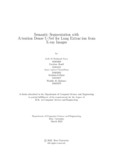| dc.contributor.advisor | Noor, Jannatun | |
| dc.contributor.author | Auvy, Akib Al Mahmud | |
| dc.contributor.author | Sharif, Shezhan | |
| dc.contributor.author | Chowdhury, Aseer Iqtider | |
| dc.contributor.author | Elahi, Mahbub-E | |
| dc.contributor.author | Mahmud, Washik Al | |
| dc.date.accessioned | 2023-08-20T05:14:16Z | |
| dc.date.available | 2023-08-20T05:14:16Z | |
| dc.date.copyright | 2023 | |
| dc.date.issued | 2023-03 | |
| dc.identifier.other | ID 18301169 | |
| dc.identifier.other | ID 18301201 | |
| dc.identifier.other | ID 18301182 | |
| dc.identifier.other | ID 18101187 | |
| dc.identifier.other | ID 18101179 | |
| dc.identifier.uri | http://hdl.handle.net/10361/19449 | |
| dc.description | This thesis is submitted in partial fulfillment of the requirements for the degree of Bachelor of Science in Computer Science, 2023. | en_US |
| dc.description | Cataloged from PDF version of thesis. | |
| dc.description | Includes bibliographical references (pages 47-50). | |
| dc.description.abstract | "In the diverse field of computer science, deep learning and digital image processing
plays a vital role in medical image research. With a deep knowledge on hand,
we can make a machine understand any medical documentation, and fourth, image
segmentation, classification, detection, identification, and segmentation have become
more reliable and precious by the day. Lung disease detection is one of the most
challenging parts of automation machine detection; to achieve that, segmentation
is vigorous. For our research purpose, we aim to seek a better-unused model for
lung segmentation, and it is fruitless to justify all the deep learning model as the
number is huge. Most of them has already been evaluated by another researcher.
This is why we have used U-net architecture (Attention Dense U-Net, Dense U-
Net, Attention U-Net, U-Net, U-Net++) to segment the lung from an X-ray image.
For the named architecture, we have used two convolutional layers. Four types of
accuracy measurement matrices were used to judge this U-Net model: accuracy,
Dice coefficient, intersection over union(IoU), and validation loss. The milestone
for our research is as follows: our collected dataset was originally 512 x 512 pixels
which we converted to 256 x 256 pixels for a 2 x 2 patch. This enables the machine
to read the image with a better result. The dataset is annotated and masked. After
that, we performed deep learning of the U-Net structure for our dataset to train the
U-Net model and segment lung pixels from an X-ray image. In this step, we first
omitted the background from the image with the help of true positive, true negative,
false positive, and false negative values. Finally, we measured our model accuracy
by the advanced accuracy measurement algorithm to justify its capability in terms
of unknown data. Following these three steps, we have found that Attention Dense
U-Net gives the best accuracy for all given parameters, with the result of accuracy:
97.48% Dice coefficient: 94.87% IoU: 93.87%. And the lowest is base U-Net with
an Accuracy score: of 96.68%, Dice Coefficient: of 92.1% IoU: of 91.75%. The
study reflects that U-Net is unsuitable for the segmentation of lungs from X-ray
images. Hence, we have suggested our approach with Attention Dense U-Net for
lung segmentation." | en_US |
| dc.description.statementofresponsibility | Akib Al Mahmud Auvy | |
| dc.description.statementofresponsibility | Shezhan Sharif | |
| dc.description.statementofresponsibility | Aseer Iqtider Chowdhury | |
| dc.description.statementofresponsibility | Mahbub-E-Elahi | |
| dc.description.statementofresponsibility | Washik Al Mahmud | |
| dc.format.extent | 50 pages | |
| dc.language.iso | en | en_US |
| dc.publisher | Brac University | en_US |
| dc.rights | Brac University theses are protected by copyright. They may be viewed from this source for any purpose, but reproduction or distribution in any format is prohibited without written permission. | |
| dc.subject | Lung | en_US |
| dc.subject | Segmentation | en_US |
| dc.subject | U-Net | en_US |
| dc.subject | Dice coefficient | en_US |
| dc.subject | IoU | en_US |
| dc.subject | Attention dense U-net | en_US |
| dc.subject | X-ray | en_US |
| dc.subject.lcsh | Lungs--Diseases | |
| dc.subject.lcsh | Image processing--Digital techniques. | |
| dc.title | Semantic segmentation with attention dense U-net for lung extraction from X-ray images | en_US |
| dc.type | Thesis | en_US |
| dc.contributor.department | Department of Computer Science and Engineering, Brac University | |
| dc.description.degree | B. Computer Science | |

